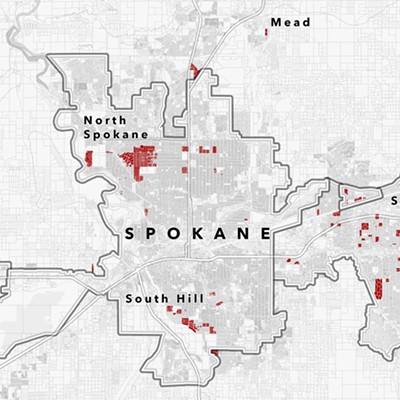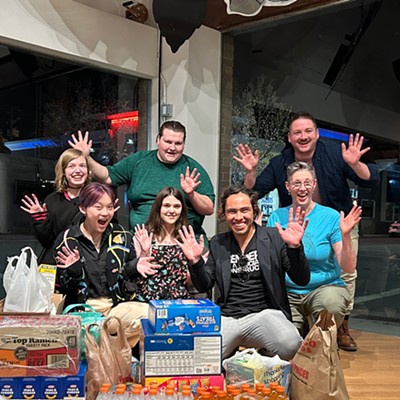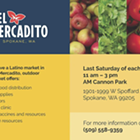Hope Harvest
[
{
"name": "Broadstreet - Instory",
"insertPoint": "5",
"component": "25846487",
"requiredCountToDisplay": "5"
},{
"name": "Broadstreet - Instory",
"insertPoint": "10",
"component": "25846487",
"requiredCountToDisplay": "10"
},{
"name": "Broadstreet - Instory",
"insertPoint": "15",
"component": "25846487",
"requiredCountToDisplay": "15"
},{
"name": "Broadstreet - Instory",
"insertPoint": "20",
"component": "25846487",
"requiredCountToDisplay": "20"
}
]
by CHRISTINA KELLY & r & & r & & lt;span class= "dropcap " & W & lt;/span & ashington State's grape harvest is in full swing this month, with a flurry of trucks loaded with plastic bins filled to the brim with inky purple, rusty red and pale green grapes, gently transported to wineries for the berries to be crushed. By all accounts, in golf terms, the 2007 harvest will hit straight down the middle of the fairway.
In fact, grape growers are predicting the 2007 harvest will stack up to the seven or eight exceptional vintages in the past 10 years, says Paul Champoux, one of the state's premiere grape growers based in Prosser.
"We're seeing smaller berries, which is good since there is less skins, making the fruit more intense," says Champoux. "In many cases, the harvest will come down to the weather [this month] when we are harvesting."
Grape growers and winemakers are hoping for an extended Indian summer -- when the days are still warm enough to complete the ripening and the nights turn crisp, but not frosty. It is the extra hang time that allows grapes to get past the greenness and vegetative state, into the next stage of sweet, fleshy fruit. As the state wine slogan touts, Washington has had the "perfect climate for grapes," with little exception, since 1997.
"Most everything is close to being ripe," says Don Townshend, winemaker of Spokane's Townshend Cellars. "There has been a little more rain lately, but we hope we'll get a little more good weather."
Townshend says his grape tonnage is down slightly from last year, especially cabernet sauvignon and merlot, but there is abundant syrah and the chardonnay came in spot-on with projected tonnage.
Each year, the Washington Association of Wine Grape Growers (WAWGG) estimates the crop just before harvest. Vicky Scharlau, WAWGG's executive director, says 2007 has the potential to be the largest crop in the state's history. The estimate for 2007 comes in at 136,447 tons of grapes, compared to 123,563 tons in 2006.
"The numbers will change between now and the end of crush -- it is dependent on the weather," Scharlau says. "The crop increase is mostly due to the newer and younger acreage coming on board -- it generally takes three to five years to produce grapes."
The larger grape crop will come in handy as the state recently licensed its 500th winery -- Sweet Valley Wines in Walla Walla. Robin Pollard, executive director of the Washington Wine Commission, says a new winery is applying for bonding every six days.
"We don't see any signs of slowing down," says Pollard.
Gordy Venneri, winemaker for Walla Walla Vintners, says the winery sources fruit from nearly a dozen vineyards in Walla Walla and the Columbia Valley. This year, along with a handful of previous years, the winter was mild, the spring was early and warm enough to get the right amount of fruit clusters and the summer has been moderately hot, with a short period of spiked temperatures in the 100s.
"Our season can depend on when that 100-degree weather hits, and for how long," says Venneri. "In 100-degree weather, the vine shuts down. Fortunately for us, we don't tend to get long stretches of 100-plus weather."
Most wineries harvest between Labor Day and Halloween, testing the patience and endurance of winemakers and grape growers. It is a time when those in the vineyard become part fortune teller and part scientist, peering into the crystal ball, rubbing their good luck stone and using science to test the sugar levels and acidity.
One prediction is that the Riesling produced from 2007 should be very good -- with high acidity that will embrace food. Those wines will be on the market by next year.
Whitestone Winery holds a fall pre-barrel tasting event on Saturday, Oct. 20, 11 am-5 pm at the winery in Wilbur, Wash., on Highway 2 about 60 miles west of Spokane. Admission is $7.50 and includes a barbecue. Visit www.whitestonewinery.com or call (509)-647-5325.
In fact, grape growers are predicting the 2007 harvest will stack up to the seven or eight exceptional vintages in the past 10 years, says Paul Champoux, one of the state's premiere grape growers based in Prosser.
"We're seeing smaller berries, which is good since there is less skins, making the fruit more intense," says Champoux. "In many cases, the harvest will come down to the weather [this month] when we are harvesting."
Grape growers and winemakers are hoping for an extended Indian summer -- when the days are still warm enough to complete the ripening and the nights turn crisp, but not frosty. It is the extra hang time that allows grapes to get past the greenness and vegetative state, into the next stage of sweet, fleshy fruit. As the state wine slogan touts, Washington has had the "perfect climate for grapes," with little exception, since 1997.
"Most everything is close to being ripe," says Don Townshend, winemaker of Spokane's Townshend Cellars. "There has been a little more rain lately, but we hope we'll get a little more good weather."
Townshend says his grape tonnage is down slightly from last year, especially cabernet sauvignon and merlot, but there is abundant syrah and the chardonnay came in spot-on with projected tonnage.
Each year, the Washington Association of Wine Grape Growers (WAWGG) estimates the crop just before harvest. Vicky Scharlau, WAWGG's executive director, says 2007 has the potential to be the largest crop in the state's history. The estimate for 2007 comes in at 136,447 tons of grapes, compared to 123,563 tons in 2006.
"The numbers will change between now and the end of crush -- it is dependent on the weather," Scharlau says. "The crop increase is mostly due to the newer and younger acreage coming on board -- it generally takes three to five years to produce grapes."
The larger grape crop will come in handy as the state recently licensed its 500th winery -- Sweet Valley Wines in Walla Walla. Robin Pollard, executive director of the Washington Wine Commission, says a new winery is applying for bonding every six days.
"We don't see any signs of slowing down," says Pollard.
Gordy Venneri, winemaker for Walla Walla Vintners, says the winery sources fruit from nearly a dozen vineyards in Walla Walla and the Columbia Valley. This year, along with a handful of previous years, the winter was mild, the spring was early and warm enough to get the right amount of fruit clusters and the summer has been moderately hot, with a short period of spiked temperatures in the 100s.
"Our season can depend on when that 100-degree weather hits, and for how long," says Venneri. "In 100-degree weather, the vine shuts down. Fortunately for us, we don't tend to get long stretches of 100-plus weather."
Most wineries harvest between Labor Day and Halloween, testing the patience and endurance of winemakers and grape growers. It is a time when those in the vineyard become part fortune teller and part scientist, peering into the crystal ball, rubbing their good luck stone and using science to test the sugar levels and acidity.
One prediction is that the Riesling produced from 2007 should be very good -- with high acidity that will embrace food. Those wines will be on the market by next year.
Whitestone Winery holds a fall pre-barrel tasting event on Saturday, Oct. 20, 11 am-5 pm at the winery in Wilbur, Wash., on Highway 2 about 60 miles west of Spokane. Admission is $7.50 and includes a barbecue. Visit www.whitestonewinery.com or call (509)-647-5325.
















